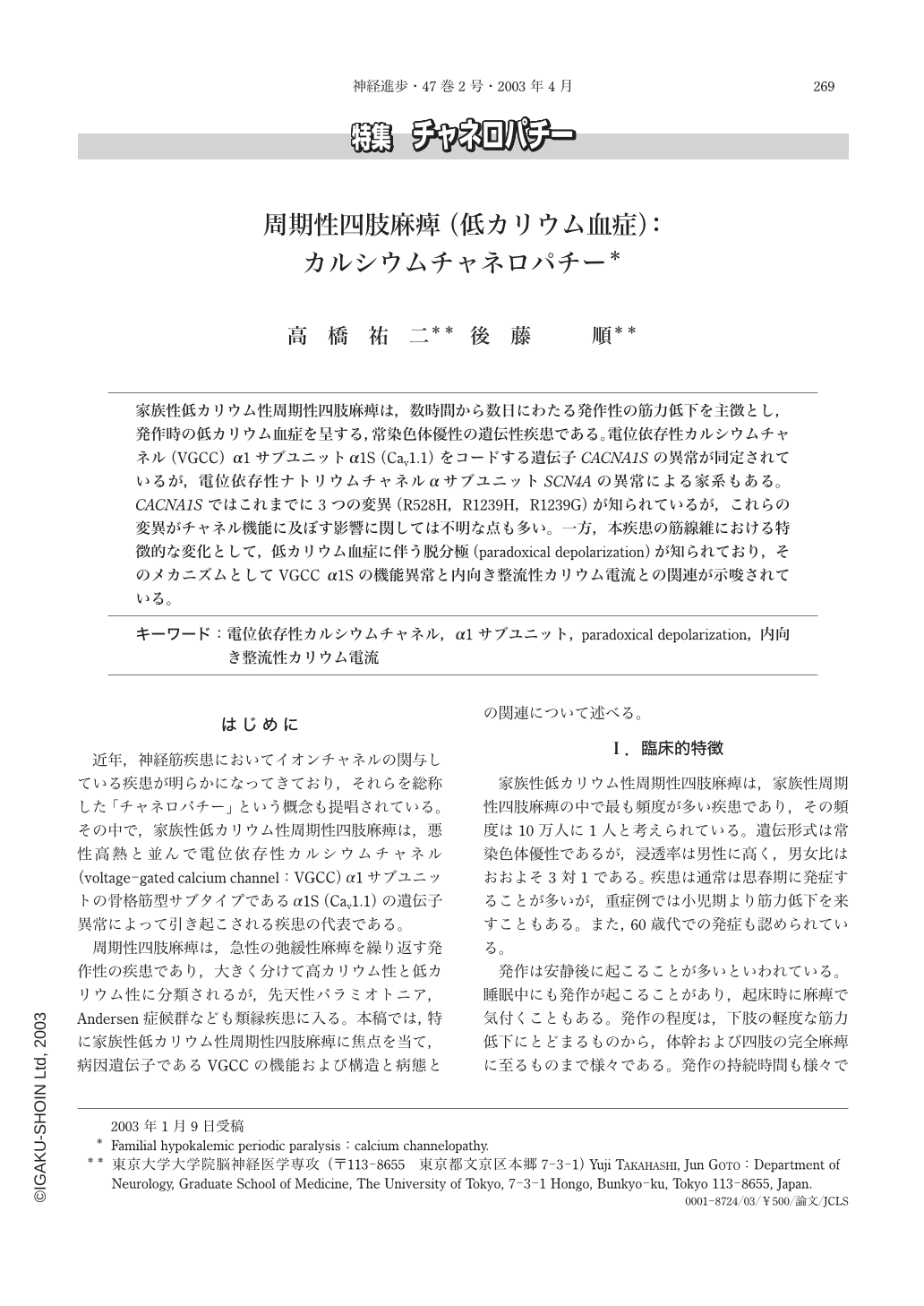Japanese
English
- 有料閲覧
- Abstract 文献概要
- 1ページ目 Look Inside
家族性低カリウム性周期性四肢麻痺は,数時間から数日にわたる発作性の筋力低下を主徴とし,発作時の低カリウム血症を呈する,常染色体優性の遺伝性疾患である。電位依存性カルシウムチャネル(VGCC)α1サブユニットα1S(CaV1.1)をコードする遺伝子CACNA1Sの異常が同定されているが,電位依存性ナトリウムチャネルαサブユニットSCN4Aの異常による家系もある。CACNA1Sではこれまでに3つの変異(R528H,R1239H,R1239G)が知られているが,これらの変異がチャネル機能に及ぼす影響に関しては不明な点も多い。一方,本疾患の筋線維における特徴的な変化として,低カリウム血症に伴う脱分極(paradoxical depolarization)が知られており,そのメカニズムとしてVGCCα1Sの機能異常と内向き整流性カリウム電流との関連が示唆されている。
はじめに
近年,神経筋疾患においてイオンチャネルの関与している疾患が明らかになってきており,それらを総称した「チャネロパチー」という概念も提唱されている。その中で,家族性低カリウム性周期性四肢麻痺は,悪性高熱と並んで電位依存性カルシウムチャネル(voltage-gated calcium channel:VGCC)α1サブユニットの骨格筋型サブタイプであるα1S(CaV1.1)の遺伝子異常によって引き起こされる疾患の代表である。
周期性四肢麻痺は,急性の弛緩性麻痺を繰り返す発作性の疾患であり,大きく分けて高カリウム性と低カリウム性に分類されるが,先天性パラミオトニア,Andersen症候群なども類縁疾患に入る。本稿では,特に家族性低カリウム性周期性四肢麻痺に焦点を当て,病因遺伝子であるVGCCの機能および構造と病態との関連について述べる。
Hypokalemic periodic paralysis(hypoPP)is an autosomal-dominant hereditary disease, which is characterized by episodic attacks of muscle weakness and hypokalemia during attacks. Paralysis may be quite severe, lasting from a few hours to several days. Attacks may be triggered by carbohydrate-rich meals, strenuous exercise, or mental stress. Typically, muscles controlling speech, swallowing, and respiration are not involved. The extent of hypokalemia during attacks varies among patients. Severe hypokalemia may be associated with cardiac arrhythmia and reduced gut motility. Serum potassium level between attacks is usually normal. Some patients show slowly progressive myopathy. Treatments include ingestion of potassium salts for acute attacks and oral administration of acetazolamide for prophylaxis.
HypoPP is genetically heterogenous. In most families, the disease maps to chromosome 1q31-32, where the geneCACNA1Sencoding theα1 subunit of L-type voltage-gated calcium channel(VGCCα1S or CaV1.1)in the skeletal muscle is located. Three point mutations have been identified:arginine-to-histidine substitutions at residues 528 and 1239(R528H and R1239H, respectively), and arginine-to-glycine substitution at residue 1239(R1239G). The former two occur with equal frequency, and the latter occurs with much less frequency. In other families, the mutations in voltage-gated sodium channelαsubunitSCN4Ahave been identified.
The mechanism that these mutations in VGCCα1S(CaV1.1)cause hypoPP is still unclear. All the mutations lie in the transmembrane segments that act as the voltage-sensor, but their effects on channel properties are not the same. The constant findings include the reduced density of the calcium currents.
One of the electrophysiological abnormalities in the affected muscle is paradoxical depolarization, that is, the muscle fibers become more depolarized when the extracellular potassium concentration is decreased. The underlying mechanism of the paradoxical depolarization is suggested to be the reduced potassium conductance of plasma membrane, which is probably caused by the abnormalities in the inward-rectifying potassium channels. However, the reasons for the mutations in VGCCα1S(CaV1.1)to be associated with the abnormalities in inward-rectifying potassium channels have not been fully elucidated.

Copyright © 2003, Igaku-Shoin Ltd. All rights reserved.


